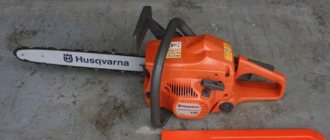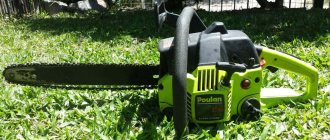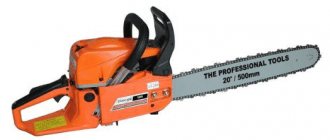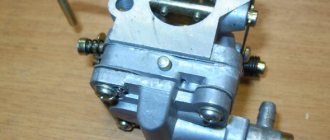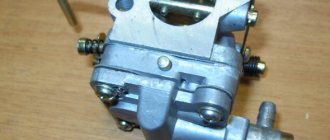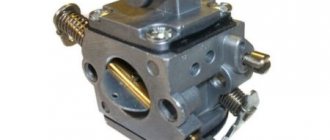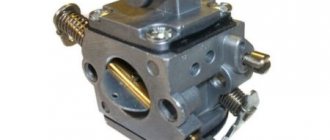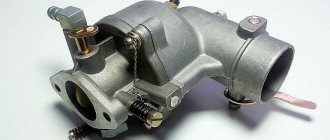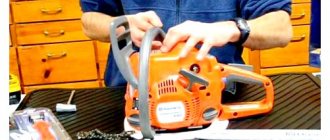A chainsaw is needed in construction, gardening, and landscaping - its presence greatly simplifies the performance of a number of wood processing tasks. The main component of this tool is the engine, the operation of which largely depends on the condition and settings of the carburetor. This is where the fuel mixture is prepared. This means that if the saw does not start, stalls, or does not provide the required power, it is likely that the reason for this is improper operation of the carburetor. Fortunately, in many cases you can deal with this on your own. Only for this you need to know and understand the structure and operating principle of this unit and, of course, the chainsaw itself.
- 2 Why is primary adjustment needed?
- 3 How to recognize carburetor failures?
- 4 Do-it-yourself disassembly: nothing complicated
4.1 Disassembling the chainsaw carburetor in the photo
Adjusting the chainsaw carburetor
The quality and performance of your chainsaw depends on many factors, but today we will talk about carburetor malfunctions. A lot depends on the operation of this node, including your good mood. You picked up the chainsaw, but it didn’t start, or it started and started sneezing and shooting, while completely losing power. Your day is ruined, and in your head there are thoughts about what is the reason, where to look for a repairman and how much the repair will cost.
Chainsaw spare parts
However, you shouldn’t despair in advance; most carburetor malfunctions can be corrected with your own hands, or adjustments can be made in a neighbor’s garage.
Prerequisites for additional adjustments
Adjustment of fuel equipment is most often carried out when the octane number of the fuel changes, sudden temperature changes in the environment, or the need for prolonged operation of the tool at high-speed operating modes.
Preliminary adjustment of the chainsaw carburetor at the break-in stage is duplicated by the final adjustment, which is recommended to be performed using test equipment from the service department. Standard equipment includes a visual indicator of mixture quality and a tachometer. After the instrument reaches operating mode, the adjustment performed at a professional level is considered to be fully implemented.
Self-adjusting a chainsaw carburetor in the field is ineffective and, in some cases, unsafe.
Changes in power characteristics may be affected by:
- low quality or incomplete fuel supply;
- water getting into the carburetor;
- clogged jet or air intake filter clogged with sawdust.
Basic faults
If you've ever been interested in the design of a carburetor, you couldn't help but notice that all the holes on the assembly are extremely small. Even minor contamination caused by poor quality fuel can result in improper fuel or air circulation. Yes, there are filters installed on the inlet and outlet ports, but they do not always cope with their task. What does this lead to? Any mechanic will tell you the consequences.
The main malfunctions of a chainsaw due to the carburetor:
- Gasoline consumption has increased, thick black smoke is pouring out of the exhaust pipe, there is a lot of burning and soot around;
- The engine starts, but sneezes and shoots into the carburetor;
- The engine has lost power, the chainsaw no longer “drags”;
- You couldn't start your chainsaw;
- It is impossible to achieve normal operation of the engine: the speed fluctuates all the time;
- The chainsaw stalls immediately after starting, or when you sharply press the accelerator trigger;
As you can see, troubles from a faulty carburetor are guaranteed. Moreover, without disassembling the unit and its subsequent adjustment, they are unlikely to be eliminated. Therefore, it makes sense to take a closer look at the carburetor design.
Design features of a manual starter
To start the chainsaw engine, you need to crank the crankshaft. This is done manually using a separate mechanism called a starter. The design of this mechanism is simple and is based on the following components:
- Drum - a part that connects to the crankshaft of a chainsaw
- A rope or cord that is wound around a drum
- Return spring - ensures winding of the cable onto the drum
- Handle - attached to the end of the cable
- The frame is the basis of the mechanism
The operating principle of this device is based on the fact that the drum teeth mesh with the teeth on the motor shaft. Moreover, engagement occurs when the cable is sharply pulled out of the drum. To start the engine, it is not enough to simply pull the starter handle. Starting the engine involves preliminary pumping fuel into the carburetor, closing the throttle and turning on the ignition. Only after this can you begin to sharply pull the starter handle.
Carburetor design
In this short review, we will not be able to describe in detail all the details of the carburetor and thoroughly familiarize ourselves with all the nuances of its operation, but we will dwell only on the main points.
The device of a carburetor on a chainsaw
The carburetor consists of the following components:
- Tube with air damper. A small wind tunnel that is designed to regulate the flow of air. The cross flap, depending on its position, reduces or increases the amount of air, leaning or enriching the fuel mixture;
- Diffuser. Made in the form of a narrowing at the end of the wind tunnel. The main task is to increase the pressure and speed of air when mixing it with fuel;
- Nozzle or sprayer. Designed to supply fuel and mix it with oxygen.
- Float chamber. A special tank that ensures a stable level of gasoline at the entrance to the air channel.
The principle of operation of the carburetor
Most often, problems with the carburetor can be fixed with your own hands. However, to do this you need to understand the basic principles of its operation.
The principle of operation of the carburetor
Carburetor operating principle:
- After starting the engine, the damper opens, through which air enters the carburetor;
- A zone of reduced pressure is created in the air wind tunnel and float chamber, causing air to be sucked through the diffuser;
- The intensity of air flow varies depending on the position in which the damper is set;
- At this time, gasoline flows from the chainsaw tank into the diffuser, where it mixes with air;
- A so-called air-fuel mixture is formed, which is directed through the intake channels directly into the combustion chamber;
Possible reasons for setup ineffectiveness
If the work performed did not give the desired result, the reason for the failure may be:
- unclear operation of the ignition system;
- clogging of the jets or reduction of their cross-section with resinous deposits, which can be removed by washing in acetone;
- When the carburetor threads are loosened, a gap may form through which air can leak.
After eliminating the detected deficiencies and malfunctions, it is recommended to repeat the carburetor adjustment in the standard sequence. If re-tuning is not effective, you must use the services of service specialists.
Unstable engine operation can also be caused by:
- air leakage through the crankshaft seals and the cylinder seat;
- Poor sparking of the electronic ignition system cannot be ruled out.
Complex faults can only be fully eliminated if appropriate repair equipment is available.
Carburetor adjustment period
Before picking up a wrench and a screwdriver, let's understand in what cases the operation of a chainsaw can be improved by adjusting the carburetor.
Carburetor adjustment is necessary if:
- Worn or damaged adjustment screws. The reason for this may be either a manufacturing defect or the vibration that accompanies the operation of the chainsaw. With this malfunction, it is possible to adjust the carburetor without removing it from the chainsaw;
- The most common cause of carburetor malfunction is contamination. The fault for this lies with the owner of the unit. Obviously, the owner did not pay enough attention to cleaning and maintaining the air filter, and even turned a blind eye to the quality of the fuel. In this case, you can’t get rid of it with just one adjustment. Now you will have to completely disassemble the assembly, blow out all the channels, wash it, remove scale and scale, and then assemble and adjust it;
Cleaning the air filter
- A new chainsaw does not need adjustment. However, over time, serious wear and tear occurs on all components, including the engine. Your chainsaw has begun to work poorly at high speeds and under load. Factory settings no longer help. In this case, you can adjust the carburetor according to other parameters, however, this is a temporary solution, one way or another it is necessary to repair the engine;
Preparation for self-tuning of fuel equipment
The sequence for adjusting the carburetor is outlined in the attached operating instructions. The factory kit includes a screwdriver for adjusting the screws marked with the letters L, H and T. Some manufacturers equip their chainsaws with carburetors, the adjustment of which requires a special adjustment key.
Correct tuning of the fuel system requires warming up the power unit to operating temperature and pre-cleaning the air intake filter element. The saw is installed in a position that provides convenient access to the fuel equipment.
Carburetor adjustment
As we have already mentioned, the manufacturer sets fairly precise settings at which your chainsaw should work well. However, during operation, individual components and parts wear out and factory settings are violated.
Moving any of the adjusting screws even a quarter turn can lead to quite unpleasant consequences.
If you notice that the chainsaw is malfunctioning, has lost power, and often stalls for no apparent reason: it’s time to adjust the carburetor.
Carburetor adjustment screws
The process of adjusting a Chinese chainsaw is carried out by manipulating three screws: H (High), L (Low) and T. Screw T, depending on where and who made your chainsaw, may be marked S or LA.
- High: regulates the operation of the chainsaw at high speeds, is responsible for the operation of the main jet;
- Low: responsible for the operation of the engine at low speeds, responsible for the idle jet;
- T (S, LA): this screw is used to adjust the optimal idle speed level;
When starting to adjust the carburetor, find the chainsaw passport with a table of rotation angles of the adjusting screws. Adjustment can be made with a special or regular flat-head screwdriver.
Step-by-step instructions for adjusting the carburetor:
- Place the chainsaw in a well-lit room or open area;
- The next stage depends on the chainsaw. On some models, adjustments can be made without removing the air filter protective cover. Other manufacturers cover the screws with a cover that must be removed;
- We begin the main stage of adjustment by manipulating screws H and L. Tighten them until they stop. When you feel resistance, turn it back one and a half turns;
- Try starting the engine. If it does not start, achieve the desired result by turning screw T clockwise, no more than ¼ turn;
Thus, we have found the starting parameters to begin adjustment.
- After starting the engine, let it warm up for 8-11 minutes;
- Using screw L, find the highest engine speed and unscrew the screw from this point ¼ turn. If you have a tachometer, this operation is best carried out with its help;
- Use the idle screw (T) to ensure normal operation of the chainsaw at idle speed;
- Check the throttle response of the engine, drive it in different modes;
- If the breakdown could not be fixed at home, then you will have to contact an experienced mechanic who has not only knowledge, but also experience;
Above is the process for adjusting the most common carburetors that are installed on Chinese-made chainsaws. The adjustment process for some branded chainsaws may differ more insignificantly.
If possible, expensive devices should be repaired in specialized workshops.
What tool is needed
In order to carry out adjustments and repairs correctly, you must have a special tool - a tachometer. With its help, you can find out the exact maximum number of engine revolutions and make adjustments in accordance with the instructions. To adjust the carburetor, use a slotted screwdriver, which fits most models. However, some models require an adjustment wrench.
Tachometer
Not all models of chainsaws can be adjusted at home, since special keys are only available in service centers operated by the manufacturer. Such measures have been taken to prevent tool malfunctions due to incorrect adjustments made by inexperienced craftsmen.
